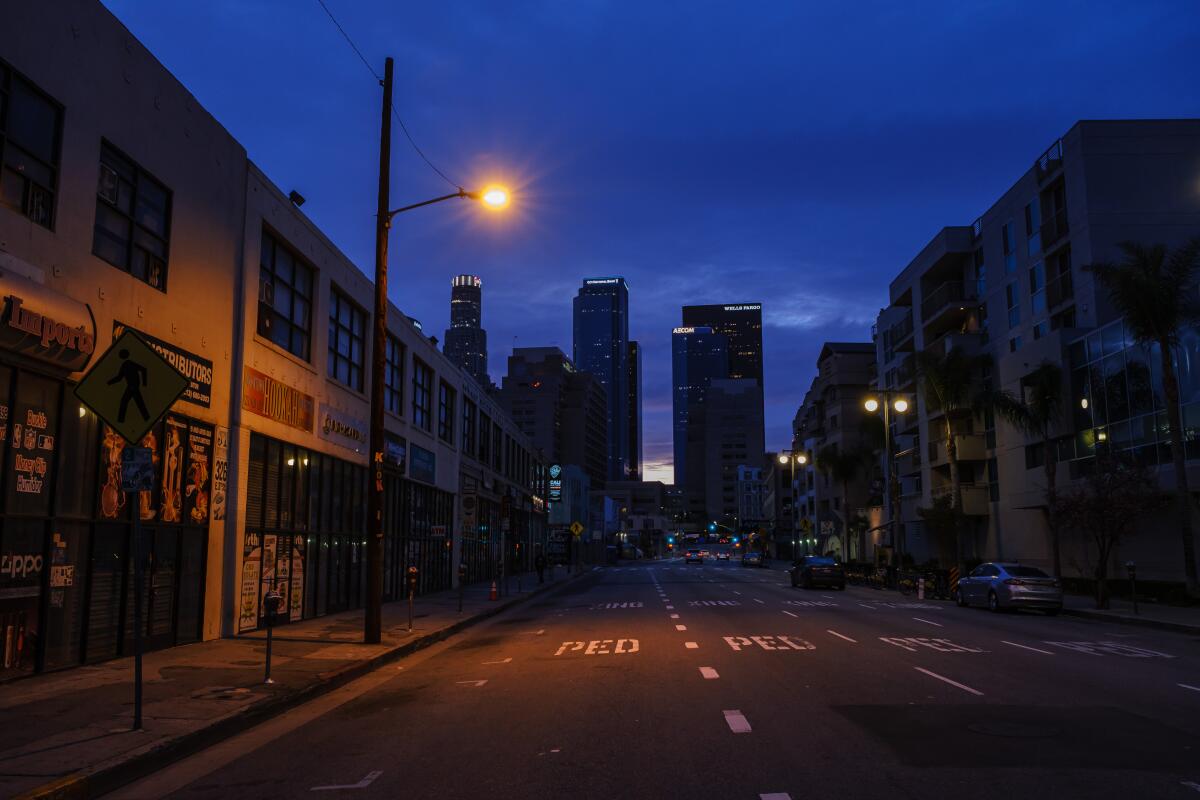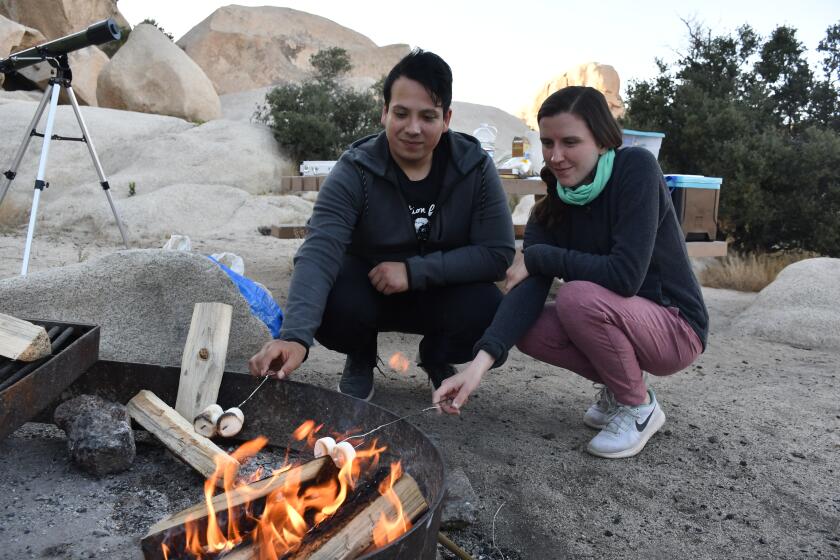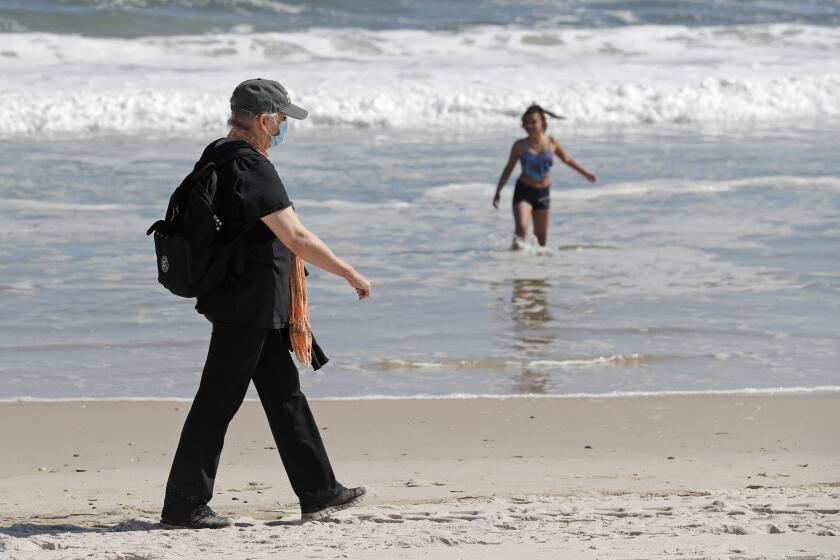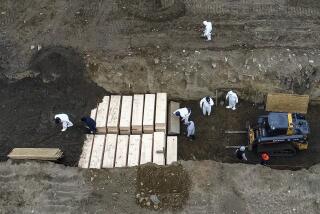How L.A. County became coronavirus epicenter: Slower shutdown, density, poverty among theories

In mid-March, as the specter of a society-upending pandemic grew, Los Angeles County emerged as something of a bright spot.
When Bay Area counties mandated on March 16 that all residents stay at home, officials said it didn’t make sense in L.A. County because far fewer cases of the coronavirus had been detected.
“We don’t have the same trajectory that they have up north,” L.A. County Public Health Director Barbara Ferrer said that day when asked about a stay-at-home order.
Two months later, the situation has shifted dramatically. L.A. County now has the highest rate of deaths from COVID-19 in the state, and the second highest infection rate. On Friday, federal officials singled out Los Angeles because of its stubbornly high case counts of the coronavirus, despite precautions to slow the spread.
With so many factors at play, it is almost impossible to know which is the culprit, especially in the midst of an evolving outbreak, experts say.
Many epidemiologists pointed to densely packed neighborhoods with overcrowded housing, as well as high rates of poverty, homelessness and even pollution that could be fueling poor outcomes in L.A. County.
The Trump administration sent a letter to L.A. Mayor Eric Garcetti saying the Department of Justice is concerned the city may pursue “an arbitrary and heavy-handed approach” to coronavirus stay-at-home orders.
Another factor might be when local officials shut down. The Bay Area issued its stay-at-home order on March 16, followed by L.A. County three days later. Though earlier than the rest of the nation, the delay may have set the stage for L.A. County to succeed the Bay Area as California’s center for COVID-19.
“The Bay Area probably figured it out sooner, and that’s why the Bay Area looked like it was worse early on,” said UCLA epidemiologist Dr. Timothy Brewer. “I think L.A. was a little bit behind S.F. and some of the surrounding areas in the Bay Area ... and now we’re seeing the after effects of that.”
L.A. County officials say that while deaths remain troublingly high, there are other indicators that the region is beginning to turn the corner. But understanding how things got so bad in the first place is going to take time.
As more businesses reopen, public lands follow suit
“The way coronavirus is playing out in some sense is unique to the different cities and the different counties around the globe,” said Amanda Daflos, chief innovation officer for the city of L.A. “We’re monitoring everything very closely.”
::
Compared with cities nationwide, Los Angeles’ rate of COVID-19 cases and deaths has been relatively low. Approximately 2,000 people have died in L.A. County of COVID-19, while in New York City, which is roughly the same population size, the death toll has crossed 20,000.
But the region has emerged as an outlier within California. In L.A. County, 426 out of every 100,000 people have tested positive for COVID-19, compared with 270 in San Francisco. In L.A., 20 out of every 100,000 residents have died of COVID-19, compared with 4 in San Francisco.
“If you look at individual counties and cities, L.A. has been a hotbed,” said UC Davis epidemiologist Bradley Pollock.
To try to make sense of these trends, data crunchers at the L.A. County Public Health Department recently ran some numbers, said chief science officer Dr. Paul Simon.
They looked into whether L.A. County’s population was older than the rest of the state’s. In Italy, an older-than-average population was believed to have contributed to that country’s alarmingly high death rate. But the L.A. County analysis found that its population was not older than the rest of the state, and perhaps even skewed a little younger, Simon said.
Analysts also looked into whether the county’s residents were more likely to have diabetes, high blood pressure or obesity compared with the rest of the state, factors that could make them more likely to die from COVID-19. Again, they found no difference, he said.
“What does that leave us with?” Simon said. The answer has been a bit of a puzzle, he said.
One piece may be the delayed stay-at-home order.
Though it appeared in March that L.A. County had less coronavirus transmission than the Bay Area, experts say that it is now clear that there was likely widespread coronavirus transmission far before it was detected, especially in Los Angeles County, with its high number of incoming travelers.
So the idea that the Bay Area had more transmission than the rest of the state was simply an indicator of who detected it first, experts say. And catching those cases early may have actually helped the Bay Area because it prompted quick action and shifted public sentiment, experts say.
In San Francisco, fewer people were going out to restaurants and other public spaces as early as late February, far before such a change was seen in L.A., said UC San Francisco epidemiologist Dr. George Rutherford. Many tech companies in the Bay Area asked their employees to work from home even before those orders, something more difficult in Los Angeles County, where fewer people work in high-tech jobs, he said.
L.A. city, the largest within the county, ordered bars and restaurants to switch to take-out only on March 15, the day before Bay Area announced its shelter-at-home order. But the countywide stay-at-home mandate didn’t come until three days after the Bay Area’s, and the true effects were probably not felt for a few days after it was ordered, based on reports of people crowding beaches the weekend after the announcement ,Rutherford said.
“Functionally, it was probably like six days later, which could represent as many as 1.5 extra generations of viral spread, which makes a big difference,” he said.
But Rutherford and other epidemiologists agreed that the delay does not account for the ongoing high rates of cases and deaths.
The city of L.A. did widely expand testing, now even for asymptomatic residents, which may be why case counts are not quickly falling despite the shutdowns, but that doesn’t explain why the death rates are also higher, experts say.
Memorial Day weekend traditionally means family barbecues, road trips, crowded parks and carefree days spent basking by the water, but Americans venturing out after weeks of sheltering in place are being asked not to let up their guard as the coronavirus continues to spread.
The most common explanation cited was density: many people living close together, creating the perfect conditions for the coronavirus to spread. Data from other regions show the virus often transmits within households due to close, prolonged contact that facilitates its spread. Once the virus gets into those settings, it can spread widely, experts say.
“The county is 10 times more dense than the state as a whole,” UCLA’s Brewer said. “If you think about where we have seen very explosive outbreaks, they’ve tended to occur in places like meat-packing plants, skilled nursing facilities, assisted living homes — places where people are spending a fair amount of time together in close contact in enclosed environments.”
L.A. County also has higher rates of poverty than all the Bay Area counties, as well as almost every urban county in the state. Poorer people are more likely to be homeless, and be unable to stay home when they are sick, have access to healthy foods and medical care, and more likely to live in polluted areas.
These factors have set the stage for outbreaks in L.A. County in the past, including typhus, hepatitis A and measles just in the last few years, said USC epidemiologist Dr. Neha Nanda.
Experts say their understanding of L.A. County‘s persistent outbreak will continue to develop in the coming months, though there are already some signs of hope.
Officials announced earlier this week that the transmission rate for the coronavirus had fallen lower than ever before. Prior to the stay-at-home orders in March, each person in L.A. County was likely infecting at least three other people. Now, that number has fallen below 1, a sign that the epidemic may begin to shrink.
But experts say that with infectious diseases, when a single case can turn into thousands, it is impossible to predict what will happen next. When it comes to L.A. County‘s outbreak, some factors are out of its control, said UCSF’s Rutherford.
“It’s also a matter of luck,” he said.
More to Read
Sign up for Essential California
The most important California stories and recommendations in your inbox every morning.
You may occasionally receive promotional content from the Los Angeles Times.













